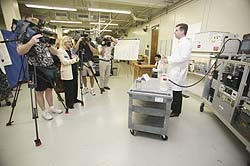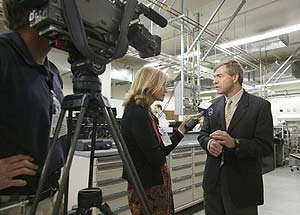Livermore Lab unveils two new centers for fundamental and applied science
LIVERMORE, Calif. — Lawrence Livermore National Laboratory today unveiled two new laboratories, one that will conduct basic science in biosecurity and environmental biology and the other that will take advances in biosciences around the Laboratory and link them to the medical community.
The BioSecurity and Nanosciences Laboratory (BSNL) serves as an incubator for exploratory science at the boundaries of chemistry, materials science and biology which is then nurtured in support of the Lab’s mission in non-proliferation, counterterrorism and life sciences. The Center for Biotechnology, Biophysical Sciences and Bioengineering (CBBB) serves as a one-stop shop where academic and private researchers can partner with any number of scientists to work on emerging medical, bioscience and environmental technologies.
With a slogan of "Team Science for Life," CBBB personnel manage a biomedical technology program within the UC Davis/LLNL Integrated Cancer Center; host seminars, briefings, workshops and symposia; represent LLNL at University of California systemwide symposia and business meetings; develop a government, foundation and private industry funding base; and serve as a point of information for the Department of Energy, the National Institutes of Health and other agencies seeking participation of LLNL in grant writing, workshops and new initiatives.
The BSNL has built a scienc>e and technology center with a mission to advance state-of-the-art technology to detect, identify and characterize biological molecules and their function. This "front-end" science enables technologies to be developed. It serves as the Laboratory’s primary provider of biochemical, biophysical and biomaterials science that can serve as counterterrorism tools or new diagnostic instruments for detecting disease.
Both centers focus on assembling multidisciplinary teams, and many BSNL scientists are also active in the CBBB, where they are able to link their research to medical and environmental applications.
For example, through the CBBB, scientists are working on a technique for single-cell cancer detection. Using a specialized technology, scientists can view the molecular composition of individual cells and distinguish a healthy cell from a cancerous cell. By using blood or urine samples, doctors could diagnose cancer earlier and with higher certainty. These techniques may be especially helpful in diagnosing leukemia patients. "
During the next 10 years, the center could become an indispensable national asset for bioscience and medicine," said Dennis Matthews, CBBB director. "By working with other agencies, foundations and private industry, we plan to develop national initiatives in the biosciences and secure additional funding."
Both centers are working on cutting edge technology. At BSNL, a flagship technology is BAMS (BioAerosal Mass Spectrometer), which can identify airborne pathogens at the single-cell level in about 100 milliseconds. By combining an understanding of laser-particle interactions, the biochemistry of bacteria, and mass analysis, BAMS has built a prototype system than can identify and differentiate between harmful anthrax spores and benign varieties, such as those found in insecticides.
Future biomedical applications could include rapid detection of respiratory diseases such as tuberculosis and SARS.
"We serve as an incubator for new ideas in support of the Laboratory’snational security missions," said Jim De Yoreo, BSNL director. "Manytimes this basic science evolves into technology that can improve human healthand environmental protection. BAMS is a great example of this evolution."
Founded in 1952, Lawrence Livermore National Laboratory is a nuclear security laboratory, with a mission to ensure national security and apply science and technology to the important issues of our time. Lawrence Livermore National Laboratory is managed by the University of California for the National Nuclear Security Administration/Department of Energy.
Contact
Anne Stark[email protected]
925-422-9799
Related Links
LLNL's BioSecurity and Nanosciences LaboratoryLLNL's Center for Biotechnology, Biophysical Sciences, and Bioengineering
Life at the Nanoscale
BAMS: When Every Second Counts
UC Davis Cancer Center






